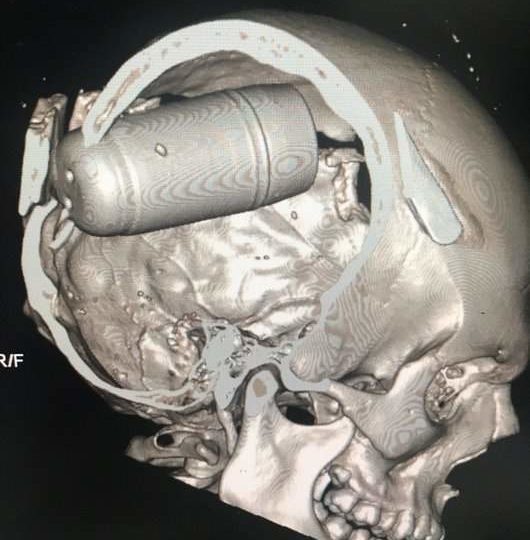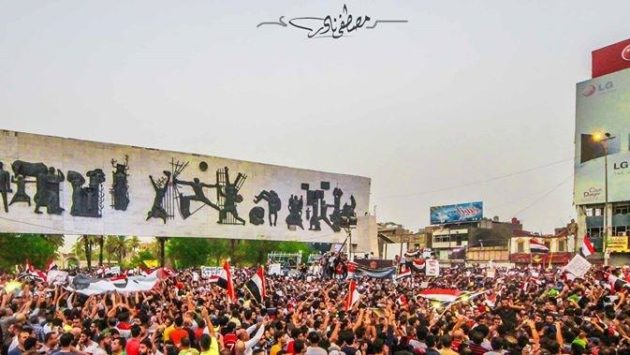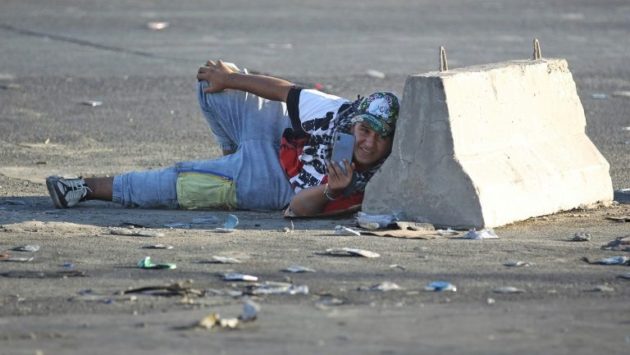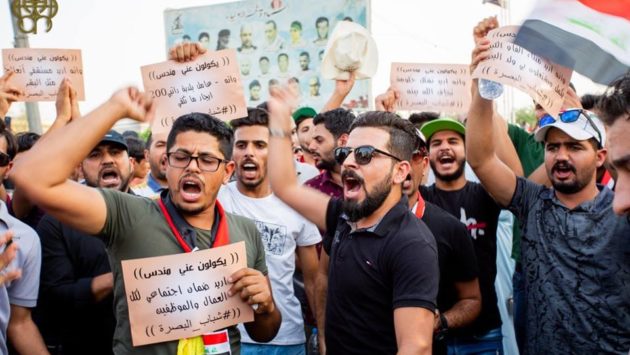Iraq: Gruesome String of Fatalities as New Tear Gas Grenades Pierce Protesters’ Skulls
CONTENT WARNING: Some of the information and imagery below is very graphic and some users might find them disturbing.
The Iraqi authorities must ensure anti-riot police and other security forces in Baghdad immediately stop using two previously unseen types of tear gas grenade to kill rather than disperse protesters, Amnesty International urged today after its investigation found they caused at least five protester deaths in as many days.
Amnesty International carried out telephone and email interviews with numerous eyewitnesses, reviewed medical records and consulted medical professionals in Baghdad as well as an independent forensic pathologist about the horrific injuries caused by these grenades since 25 October.
The organization’s Digital Verification Corps geolocated and analyzed video evidence from near Baghdad’s Tahrir Square documenting the fatalities and injuries – including charred flesh and “smoking” head wounds. Its military expert identified the types of tear gas grenades being used as two variants from Bulgaria and Serbia that are modelled on military grenades and are up to 10 times as heavy as standard tear gas canisters, resulting in horrific injuries and death when fired directly at protesters.“All the evidence points to Iraqi security forces deploying these military-grade grenades against protesters in Baghdad, apparently aiming for their heads or bodies at point-blank range. This has had devastating results, in multiple cases piercing the victims’ skulls, resulting in gruesome wounds and death after the grenades embed inside their heads. Lynn Maalouf, Middle East Research Director at Amnesty International
“All the evidence points to Iraqi security forces deploying these military-grade grenades against protesters in Baghdad, apparently aiming for their heads or bodies at point-blank range. This has had devastating results, in multiple cases piercing the victims’ skulls, resulting in gruesome wounds and death after the grenades embed inside their heads,” said Lynn Maalouf, Middle East Research Director at Amnesty International.
“The lack of accountability for unlawful killings and injuries by security forces, responsible for the vast majority of casualties this past month, is sending the message that they can kill and maim with impunity. The authorities must rein in the police, ensure prompt, impartial, effective investigations, and prosecute those responsible.”
Eyewitness testimonies
Amnesty International interviewed nine eyewitnesses – including protesters and medical volunteers – who described the police use of these tear gas grenades near Baghdad’s Tahrir Square between 25 and 29 October.
Witnesses described how earlier in October anti-riot police had used hand-thrown tear gas canisters, but switched to firing the grenades on or around 25 October, and the deaths and injuries have spiked since then. Multiple witnesses said up to 10 grenades – which the protesters refer to as ‘smokers’ – are fired at a time into crowded areas, emitting a type of smoke that smells different from any tear gas they had previously witnessed.
One female protester told Amnesty International: “One [‘smoker’] landed close to me and I could barely breathe. It was like my chest was broken. The medical volunteers gave me a ventilator. I think I would have died. I have been exposed to tear gas before and it did not feel this way.”Since 25 October, the anti-riot [police] has not stopped launching tear gas and ‘smokers’ into the crowd, whether provoked or not. It is continuous and random. … They are not using them to disperse, they are using them to kill. All the deaths in Baghdad have been from these canisters going inside the protesters’ bodies. They do not think about the fact that there are families and children in the crowds. Male protester in Baghdad
One male protester said: “Since 25 October, the anti-riot [police] has not stopped launching tear gas and ‘smokers’ into the crowd, whether provoked or not. It is continuous and random. … They are not using them to disperse, they are using them to kill. All the deaths in Baghdad have been from these canisters going inside the protesters’ bodies. They do not think about the fact that there are families and children in the crowds.”
Another male protester told Amnesty International his friend was killed after being hit in the head with one of the grenades on 28 October, and he personally witnessed another death and an injury caused by security forces using them on 26 October.
“I saw the ‘smoker’ hit a man in the waist and it charred his clothes. It ripped his clothes away. … The grenade came from about 150-200 metres away. He fell right where he was and we dragged him to the tuktuk. The grenade came horizontally,” the protester said. “I saw another man … that was hit in the shoulder. I did not see the moment of impact but he was screaming a lot.”
Another male protester described how a man who got one of the grenades lodged in his skull fell instantly to the ground and smoke was coming out of his head.
Medical volunteers described how the grenades were being fired directly into crowded areas of peaceful protesters, causing people, including children, to faint or suffocate: One said: “They fire it straight into the crowds. Not in the air. Directly at people. It’s savage.”
Video evidence of gruesome casualties
Amnesty International discovered, verified and geolocated several online videos filmed between 25 and 29 October in areas near central Baghdad’s Tahrir Square, a focal point of the protests.
These videos showed five men who had suffered severe head trauma apparently caused by grenades. In one video filmed on 25 October on the north-eastern side of Jimhouriya Bridge, a male protester can be seen unconscious or dead, with a clear wound in the back of his skull from which smoke or gas is seeping.
The same effects can be seen in another video filmed the same day in the same location – here a different male protester has a similar wound on the right of his skull. Another video filmed on either 25 or 26 October shows a group of protesters walking over Jimhouriya Bridge in the direction of the city’s Green Zone. Suddenly, a male protester falls to the ground clutching his head. Plumes of smoke or gas are seen coming from the wound.
Amnesty International received CAT-scan imagery from medical workers in Baghdad. The imagery, which Amnesty has verified, confirms deaths caused by severe head trauma. The horrific injuries in all of these images are caused by entire grenades embedded in the victims’ skulls.
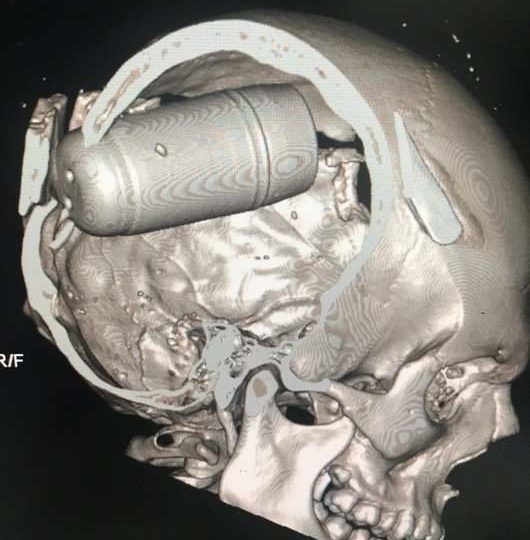
Military-grade grenades used on protesters
Two models of grenade are responsible for these injuries: Serbian 40mm M99s, manufactured by Balkan Novotech, and 40mm LV CS grenades, likely manufactured by Bulgarian company Arsenal. Unlike most tear gas grenades used by police forces around the world, these two types are modelled after offensive military grenades designed for combat. Research by Amnesty International has found that due to their weight and construction they are far more hazardous to protesters.
A typical 37mm police-style tear gas grenade weighs between 25 and 50 grams, and consists of several smaller canisters that separate and spread out over an area. In contrast, the Serbian and Bulgarian 40mm military-style grenades documented in Baghdad consist of a single heavy slug and are between five and 10 times heavier, weighing 220 to 250 grams.As both the police and military grenades are fired with a similar muzzle velocity, meaning they travel through the air at the same speed, the grenades that weigh 10 times as much deliver 10 times the force when they strike a protester. This is why they have caused such horrific injuries. Brian Castner, Amnesty International’s Senior Crisis Adviser on Arms and Military Operations
“As both the police and military grenades are fired with a similar muzzle velocity, meaning they travel through the air at the same speed, the grenades that weigh 10 times as much deliver 10 times the force when they strike a protester. This is why they have caused such horrific injuries,” said Brian Castner, Amnesty International’s Senior Crisis Adviser on Arms and Military Operations.
Unprecedented pattern of death
All less-lethal weapons can kill when used incorrectly. And tear gas canisters should never be fired directly at people. However, all experts interviewed by Amnesty International – including military and policing experts, medical doctors, and forensic pathologists – agree that both the number of deaths and horrific nature of the injuries from the point-blank firing of these heavy 40mm tear gas grenades is unprecedented.
A forensic pathologist confirmed to Amnesty International that they had “never seen such severe injuries from this cause before”. The expert noted that “the severity of injury and the angles of entry” strongly suggest the grenades were fired directly at the victims rather than ricocheting off the ground.
Speaking to Amnesty International on condition of anonymity, a medical worker at a hospital close to Tahrir Square to which the majority of victims with head trauma were taken, reported that the facility had received “six to seven head injuries per day since Friday [25 October]”. “Of those, five had metal projectiles or canister[s] lodged into their skulls”. The medical worker said that they had never seen such injuries in such frequency before.
“Any less-lethal weapon designed for crowd control can be deadly if deployed incorrectly. But what we’ve documented with these grenades in Baghdad goes far beyond misuse of a ‘safer’ weapon – the very design of the grenades being used is maximizing the horrific injuries and death. Iraq’s police force must recall them from use immediately. There must be an independent and impartial investigation into their use and into other cases of unlawful killings and injuries during the protests,” said Lynn Maalouf.

